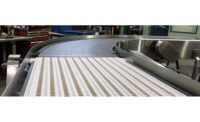Effective and forward-thinking approaches toward water management can help snack and bakery processors save money, produce more efficiently and draw on less energy, resulting in reduced environmental impact.
Reduce, reuse, recycle
Snack and bakery facilities have been continuously trying to draw down their water usage over the years, says Rod Martell, food safety auditor, AIB International Inc., Manhattan, KS. “They are trying to use less and less and less water,” he says. “It’s for a couple of reasons. No. 1, of course, is resource conservation.”
The cost of water varies across the country, so the degree of cost savings—and, often, the associated level of importance—changes from one location to the next. But the general pattern across the overall industry is toward reduced water usage.
Where facilities once instructed technicians to simply pick up a hose and wash down the floor whenever necessary, now they’re turning more to techniques like moving waste around with squeegee brushes, Martell says. And, over time, many facilities have realized that from a sanitation standpoint, they can operate for 13 days and then shut down for one, rather than cleaning more often. “That’s saved a lot on water conservation,” he says.
Properly placed, well maintained drains are another key consideration when it comes to water management, Martell says. In factories with multiple levels, you want to get away from overhead drains, he says. “Being around the product zones, that’s especially not a good idea. You’ve got to shoot drains straight down, if you can. And make sure there are no leaks in the pipes.”
Making sure there are no cracks in the drains helps keep a lid on microorganism buildup, Martell says. “You’ve got to seal your floors and keep them sealed,” he says. “Plants have done great things with drains, and plants have neglected drains, and you can tell the difference. And then you’ve got to keep the floors in good repair and keep the floors dry, especially if you don’t have drains.”
In the bakery industry, in particular, facilities need dry floors, Martell says. “Water is the enemy in the bakery, especially in the mixing area.”
On the snack food side, where Martell worked for 16 years before joining AIB a decade ago, he’s seen innovative water management processes in making corn chips, for example. Facilities send the corn and water to the processing line, and then excess water drains into a stainless-steel collection vessel.
“Whatever that reservoir would hold, it would find its way back to the corn cooked area and would be used again, only to push the corn back,” says Martell. The water would not be used to cook the corn again, but instead would be used for transporting the corn, moving the product around, instead of using fresh water for those tasks, he notes.
Similarly, on a potato chip line, potatoes are moved using a water flume in a closed-loop system. Although some water is added here and there to compensate for leaks, for the most part that water stays there, Martell says. “It does not go anywhere else in the plant.” The producer will closely monitor that environment for pathogens like Salmonella. “They have to keep that area clean if they’re going to use water back there,” he notes.
Now potato chip producers are monitoring whether they could use such a closed-loop system to wash down some of their equipment, like potato peelers, for example, without fostering the growth of microorganisms, Martell says. But those concepts are more in the test-and-learn stage than anything that’s being rolled out on the front lines. Still, they could be the next innovation, he says.
Wastewater innovations
Water that isn’t recycled and reused need to exit the plant somewhere, which means snack and bakery facilities need to find a cost-effective exit strategy that also meets municipal wastewater environmental standards.
Equipment from Baswood Corp., Allen, TX, is well tailored to handle wastewater treatment and disposal for snack and bakery facilities due to that equipment’s smaller footprint, ability to use less water and energy, and lower operating costs, says CEO Dan Simon. That’s because instead of a large lagoon, Baswood has patented technology enabling aerobic and anaerobic digestion in a self-contained, fully automated tank, he says.
Like any type of industry, snack and bakery companies are hesitant to take on costs on the back end that don’t directly contribute to the bottom line, Simon says. But as cities have grown, regulation for wastewater disposal has gotten stricter—and Baswood’s solution addresses this aspect of the business, he says.
“We can handle plants that have fluctuating demands—with lots of production, and then none,” says Simon. “And we’re in the second generation of automation.” Now, with integrated technological controls, these plants can be operated and managed using an iPhone,” he says. “In terms of being able to observe and manage what’s going on, it’s fully automated.”
FOG—fat, oils and grease—can pose problems in some production facilities. Although the company has primarily worked with restaurants and supermarkets to date, Pilot & Navigator, Inc., Honolulu, would like to help snack and bakery facilities address the perennial issue of FOG getting into their sewer systems. The company tackles issues with FOG via atomic reduction that cuts through the FOG using nanotechnology rather than a chemical or biological approach, says David Flagg, president.
“The biological product is dormant in the bottle. When it’s diluted upon application, then it ‘makes up,’” says Flagg. That can take several hours to happen and requires just the right time and temperature. “Nanotech works on the bonds, on the electrical charge within the molecule itself, that hold the FOG together.”
Potential customers often can’t believe what Flagg describes to them, telling him, “You don’t know how greasy our hood gets.” But the solution can clean such surfaces down to the metal, he notes. For wastewater in a food processing plant, he adds, “you’re opening up a whole new world of what is possible and measurable.”











